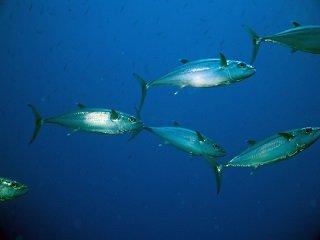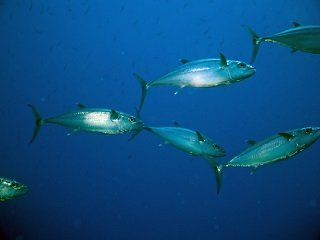 Today’s Fish File takes us to salty waters, where we’ll shine the spotlight on one of the most targeted species in the ocean, the Spanish mackerel. Found in waters all over the world, Spanish mackerel are popular among anglers due to their smaller size and fighting strength. Keep reading to learn more about this exciting saltwater fish!
Today’s Fish File takes us to salty waters, where we’ll shine the spotlight on one of the most targeted species in the ocean, the Spanish mackerel. Found in waters all over the world, Spanish mackerel are popular among anglers due to their smaller size and fighting strength. Keep reading to learn more about this exciting saltwater fish!
Spanish mackerel typically possess a green back, with silver sides marked with roughly three rows of round or oval yellow spots. They have two dorsal fins—one near their head and one on their back, along with a single row of large, edged teeth in each jaw, similar to a bluefish. Spanish mackerel don’t grow very large; males on average grow to 15-20 inches, while females grow larger, sometimes reaching lengths of over 30 inches.
Typically a shallow water species, Spanish mackerel tend to remain near sandy bottom waters with depths between 10 and 40 feet. They are aggressive feeders, and feed primarily on smaller fish species, such as herring, alewives, or anchovies, as well as squid and shrimp.
Anglers seeking Spanish mackerel can employ a few different techniques to catch them. If you’re fishing with artificial lures, I suggest using spoons, minnow lures, or jigs with 6-12 pound test line, as well as a heavy monofilament leader or a small diameter wire leader. Due to the mackerel’s teeth a strong leader is a must. A good way to locate schooling mackerel is to look for birds such as pelicans and terns. If you see groups of them working a small area it’s a good indication that they are feeding on a school of baitfish. In the absence of the birds, look for a large patch of disturbed water. If mackerel are around it’s a good bet that they will be under the baitfish and feeding on them. Another way to locate schools of fish is to troll with a spoon or jig. Even at a slow speed you can cover a lot of water in a short period of time, and eventually you’ll find some fish. When you hook the first fish continue to work the area, as they are a schooling fish, meaning there will be more than one nearby. When using bait, keep in mind that Spanish mackerel like live shrimp or baitfish. Simply, hook the bait and free-line it in the water column by trolling near schools of fish.
Spanish mackerel are an abundant, feisty, and popular species among saltwater anglers. They can be caught using a variety of tactics and taste great when cooked. If you find yourself in saltier waters anytime soon, and are looking for steady, thrilling action, look for bird or baitfish action, cast out your line, and hold on tight for a mackerel fight!








